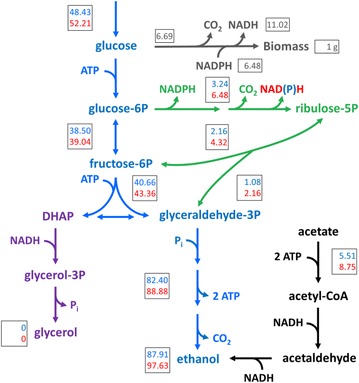Fig. 4.

Theoretical stoichiometric comparison of the anaerobic metabolism of acetate reducing S. cerevisiae expressing a strictly NAD+-dependent 6-PGDH to acetate reducing S. cerevisiae expressing the native 6-PGDH. Numbers in boxes represent the carbon distribution and grey numbers in boxes represent the requirement for glucose and cofactors in mmol g−1x, normalized for the formation of 1 g of biomass in the two scenarios: native, NADP+-dependent 6-PGDH (top, blue colour) and heterologous, NAD+-dependent 6-PGDH (bottom, red colour). Blue glycolysis and alcoholic fermentation; Green pentose-phosphate pathway; Purple glycerol formation pathway; Black acetate to ethanol reduction pathway. Grey biosynthesis according to [68], which, together with the ATP requirement for biosynthesis, was assumed to be identical for both scenarios. Glycerol formation in this case was assumed to be zero. The Acs-catalysed reaction requires the hydrolysis of ATP to AMP and pyrophosphate, which is stoichiometrically equivalent to hydrolysis of 2 ATP to 2 ADP. The oxidative branch of the pentose phosphate pathway was assumed to be the only NADPH formation pathway. Figure adapted from [21]
